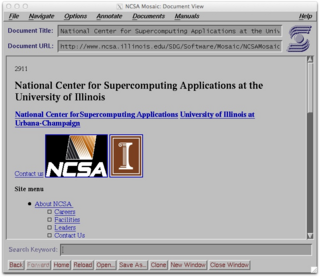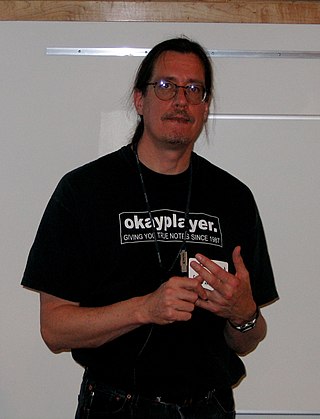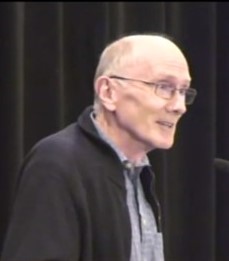
Sir Timothy John Berners-Lee, also known as TimBL, is an English computer scientist best known as the inventor of the World Wide Web, the HTML markup language, the URL system, and HTTP. He is a professorial research fellow at the University of Oxford and a professor emeritus at the Massachusetts Institute of Technology (MIT).

The World Wide Web is an information system that enables content sharing over the Internet through user-friendly ways meant to appeal to users beyond IT specialists and hobbyists. It allows documents and other web resources to be accessed over the Internet according to specific rules of the Hypertext Transfer Protocol (HTTP).

NCSA Mosaic is a discontinued web browser, and one of the first to be widely available. It was instrumental in popularizing the World Wide Web and the general Internet by integrating multimedia such as text and graphics. It was named for its support of multiple Internet protocols, such as Hypertext Transfer Protocol, File Transfer Protocol, Network News Transfer Protocol, and Gopher. Its intuitive interface, reliability, personal computer support, and simple installation all contributed to its popularity within the web. Mosaic is the first browser to display images inline with text instead of in a separate window. It is often described as the first graphical web browser, though it was preceded by WorldWideWeb, the lesser-known Erwise, and ViolaWWW.

Cello is an early, discontinued graphical web browser for Windows 3.1; it was developed by Thomas R. Bruce of the Legal Information Institute at Cornell Law School. It was released as shareware in 1993. While other browsers ran on various Unix machines, Cello was the first web browser for Microsoft Windows, using the winsock system to access the Internet. In addition to the basic Windows, Cello worked on Windows NT 3.5 and with small modifications on OS/2.

Archie is a tool for indexing FTP archives, allowing users to more easily identify specific files. It is considered the first Internet search engine. The original implementation was written in 1990 by Alan Emtage, then a postgraduate student at McGill University in Montreal, Canada.
Veronica was a search engine system for the Gopher protocol, released in November 1992 by Steven Foster and Fred Barrie at the University of Nevada, Reno.

The Entrez Global Query Cross-Database Search System is a federated search engine, or web portal that allows users to search many discrete health sciences databases at the National Center for Biotechnology Information (NCBI) website. The NCBI is a part of the National Library of Medicine (NLM), which is itself a department of the National Institutes of Health (NIH), which in turn is a part of the United States Department of Health and Human Services. The name "Entrez" was chosen to reflect the spirit of welcoming the public to search the content available from the NLM.

Robert Cailliau is a Belgian informatics engineer who proposed the first (pre-www) hypertext system for CERN in 1987 and collaborated with Tim Berners-Lee on the World Wide Web from before it got its name. He designed the historical logo of the WWW, organized the first International World Wide Web Conference at CERN in 1994 and helped transfer Web development from CERN to the global Web consortium in 1995. He is listed as co-author of How the Web Was Born by James Gillies, the first book-length account of the origins of the World Wide Web.

The Line Mode Browser is the second web browser ever created. The browser was the first demonstrated to be portable to several different operating systems. Operated from a simple command-line interface, it could be widely used on many computers and computer terminals throughout the Internet. The browser was developed starting in 1990, and then supported by the World Wide Web Consortium (W3C) as an example and test application for the libwww library.
Nicola Pellow is an English mathematician and information scientist who was one of the nineteen members of the WWW Project at CERN working with Tim Berners-Lee. She joined the project in November 1990, while an undergraduate maths student enrolled on a sandwich course at Leicester Polytechnic. Pellow recalled having little experience with programming languages, "... apart from using a bit of Pascal and FORTRAN as part of my degree course."

Mark Perry McCahill is an American computer scientist and Internet pioneer. He has developed and popularized a number of Internet technologies since the late 1980s, including the Gopher protocol, Uniform Resource Locators (URLs), and POPmail.

A search engine is a software system that provides hyperlinks to web pages and other relevant information on the World Wide Web in response to a user's query. The query is typically done within a web browser or a mobile app, and the search results are usually presented as a list of hyperlinks, often accompanied by textual summaries and images.

The World Wide Web is a global information medium which users can access via computers connected to the Internet. The term is often mistakenly used as a synonym for the Internet, but the Web is a service that operates over the Internet, just as email and Usenet do. The history of the Internet and the history of hypertext date back significantly further than that of the World Wide Web.
Search engine indexing is the collecting, parsing, and storing of data to facilitate fast and accurate information retrieval. Index design incorporates interdisciplinary concepts from linguistics, cognitive psychology, mathematics, informatics, and computer science. An alternate name for the process, in the context of search engines designed to find web pages on the Internet, is web indexing.

The School of Computer Science is an academic department in the Faculty of Science at McGill University in Montreal, Quebec, Canada. The School is the second most funded computer science department in Canada. As of 2024, it has 43 faculty members, 60 Ph.D. students and 100 Master's students.

Brian Edward Carpenter is a British Internet engineer and a former chair of the Internet Engineering Task Force (IETF), the Internet Architecture Board (IAB), and the Internet Society.
Harrison College is a co-educational grammar school in Bridgetown, Barbados. Founded in 1733, the school takes its name from Thomas Harrison, a Bridgetown merchant, who intended it to serve as "A Public and Free School for the poor and indigent boys of the parish".
Martijn Koster is a Dutch software engineer noted for his pioneering work on Internet searching.

This page provides a full timeline of web search engines, starting from the WHOis in 1982, the Archie search engine in 1990, and subsequent developments in the field. It is complementary to the history of web search engines page that provides more qualitative detail on the history.














